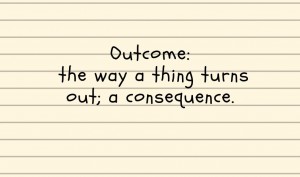Although it doesn’t always feel like it, we have come a long way in the communications world this year. Looking at outcomes rather than outputs is a good way to help yourself recognise what you have achieved.
What’s the difference?
Of course, outputs and outcomes sound very similar. So what does each term mean? How do they differ from each other?
Here are a couple of definitions that help to make it clearer:
In the context of communication, when we talk about outputs, we mean things like:
- The number of tweets you have sent about your fundraising event
- The amount of press coverage your new campaign has received
- The e-newsletter you have produced each month.
The outcomes of these activities are different to this and will include consequences such as:
- The amount of donations raised through your fundraising event (as a result of people seeing your tweets, understanding why your cause matters and deciding to take part)
- The number of signatures on your petition to change the way that young people access mental health services (as a result of a wider audience seeing information about your campaign and why it matters in the press)
- Your people feeling involved in something bigger and therefore committing their time and effort to their role (as a result of seeing their own work in the context of other stories about your organisation and understanding how it all fits together)
Why does it matter?
It’s very easy as a communicator to focus on the outputs of your activity. That is often the simplest thing to identify and to show to others in your organisation as ‘proof’ of your worth.
But unfortunately the reality is that you could, for example, have posted hundreds of tweets about your event without anyone reading them. Or without anyone reading them and deciding to take part and raise money.
In other words, you might have spent time and energy on communication activities (outputs) that haven’t added a great deal to your organisation and the people and communities you work with (outcomes).
Outcomes from this year
There is no denying 2020 has been a tough year. At times, communication has felt like a lot of work for little gain. But your work has made a difference.
Here are just a few examples of communication outcomes I have seen this year:
- Vast numbers of people changed from working in the office to working from home, literally over-night. They needed information and understanding to do that.
- Neighbours felt supported. Community groups looked out for each other, collecting prescriptions, buying food and generally checking in. Communication was central to providing information about who to contact and what support was available.
- People found their voice and started to be heard. There are many examples of individuals and communities speaking up about injustice and their experiences. Platforms for those voices were provided, often by communicators. There may still be a very long way to go, but everything has to start somewhere.
I’d love to hear about the outcomes you have achieved – drop me a line or message me on social media.
Tips to identify your desired outcome
There are lots of tools and techniques you can use to help you work out where the line lies between your communication outputs and the outcomes you need to achieve. Being aware that this distinction exists is a great first step.
1. When you are putting together your communication strategies and plans always ask yourself ‘so what’. Why does the activity you are planning matter? What do you want people to think/feel/do as a result? If you ask yourself this question at the very beginning, it will help you to build your plan to achieve it.
2. Use the ‘5 whys’ technique. This great technique helps you to go beyond the surface reasons for why you need to do something. It helps you identify the core reasons for why your work matters. It is deceptively simple. When I introduced it to attendees at Dawn Newton’s Charity Meetup last year, we received lots of positive feedback on the benefits of using it.
3. Sometimes it can work really well to start by thinking about what you do NOT want to happen. Once you’re clear on the things you want to avoid, you can flip your thinking to work out what you DO want to see.
If you need help to identify the outcomes for communication at your organisation, please feel free to get in touch for a no obligation chat about how I can support you.
Until next time
Sarah


